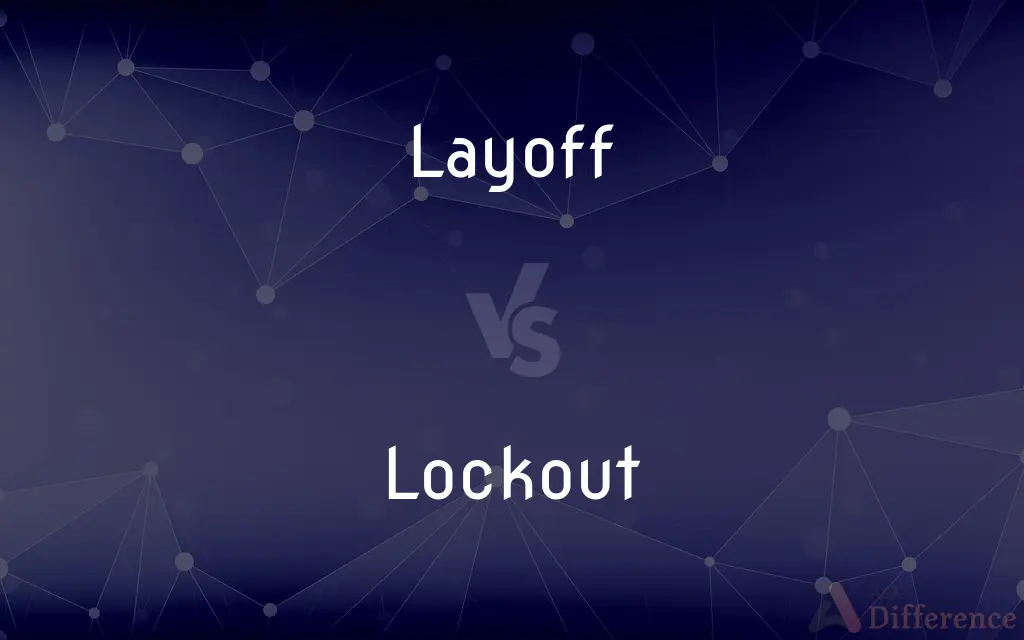Layoff vs. Lockout — What's the Difference?
By Tayyaba Rehman — Updated on September 19, 2023
A Layoff is when employees are let go due to lack of work or economic reasons. A Lockout is when employers prevent workers from working, often due to labor disputes.

Difference Between Layoff and Lockout
Table of Contents
ADVERTISEMENT
Key Differences
A Layoff typically refers to the temporary or permanent dismissal of employees, usually due to economic downturns, restructuring, or other business-related reasons. On the other hand, a Lockout occurs when employers prohibit their workers from entering the workplace, often in response to labor disagreements or disputes.
Companies may resort to Layoffs as a cost-saving measure, especially during challenging economic times. In contrast, Lockouts are more strategic and are used as leverage in negotiations, particularly when there are unresolved labor issues between employers and unions.
The consequences of a Layoff are often felt deeply by the affected employees, who might face economic hardships. In the scenario of a Lockout, both parties - the workers and the employers - usually face the implications. Workers are denied wages, while businesses may face operational disruptions.
It's worth noting that while a Layoff suggests that the employer can't afford to retain all employees or doesn't have enough work, a Lockout is more about disagreements and disputes rather than financial incapability.
Ultimately, both Layoff and Lockout represent challenging periods for businesses and their employees. While a Layoff speaks to broader economic or company-specific issues, a Lockout indicates deeper issues in labor relations and negotiations.
ADVERTISEMENT
Comparison Chart
Definition
Dismissal of employees, usually for economic reasons.
Prohibiting workers from entering the workplace, often due to labor disputes.
Initiator
Employer due to business conditions.
Employer in response to labor disagreements.
Duration
Can be temporary or permanent.
Typically temporary until a resolution is reached.
Main Cause
Economic downturn, restructuring, lack of work.
Labor disputes, disagreements between management and unions.
Impact on Employees
Loss of job and income.
Unable to work and earn, though still technically employed.
Compare with Definitions
Layoff
Employees are let go with the possibility of rehire.
Seasonal workers often face a Layoff during off-peak months.
Lockout
Employers' tool during negotiations.
The management initiated a Lockout after failing to reach an agreement with the union.
Layoff
Discharge due to organizational changes.
The merger resulted in a Layoff of several departments.
Lockout
Workers are barred from their workplace.
The Lockout left hundreds of employees stranded outside the factory gates.
Layoff
Release of employees due to financial strains.
The company announced a Layoff of 500 workers due to declining sales.
Lockout
Used to pressure the opposing party.
The union members decided to negotiate after a week-long Lockout.
Layoff
Decreasing staff numbers due to strategic decisions.
The tech firm's Layoff was a move towards automation.
Lockout
Lasts until a resolution is reached.
The Lockout ended after both parties agreed on the new terms.
Layoff
A layoff or downsizing is the temporary suspension or permanent termination of employment of an employee or, more commonly, a group of employees (collective layoff) for business reasons, such as personnel management or downsizing (reducing the size of) an organization. Originally, layoff referred exclusively to a temporary interruption in work, or employment but this has evolved to a permanent elimination of a position in both British and US English, requiring the addition of "temporary" to specify the original meaning of the word.
Lockout
The withholding of work from employees and closing down of a workplace by an employer during a labor dispute. Also called shutout.
Layoff
The act of suspending or dismissing an employee, as for lack of work or because of corporate reorganization.
Lockout
(labor) The opposite of a strike; a labor disruption where management refuses to allow workers into a plant to work even if they are willing.
Layoff
A period of temporary inactivity or rest.
Lockout
The action of installing a lock to keep someone out of an area, such as eviction of a tenant by changing the lock.
Layoff
A dismissal of employees from their jobs because of tightened budgetary constraints or work shortage (not due to poor performance or misconduct).
Lockout
(by extension) The exclusion of certain people from a place, event, situation, etc.
It's another front-row lockout for Mercedes on the starting grid of the Japanese Grand Prix.
Layoff
A period of time when someone is unavailable for work.
Lockout
The restriction of a population to a certain area, but allowing free movement within that region, in order to prevent the spread of disease. Compare lockdown.
Layoff
A short pass that has been rolled in front of another player for them to kick.
Lockout
(computing) A situation where the system is not responding to input.
Layoff
A bet that is laid off, i.e. placed with another bookmaker in order to reduce risk.
Lockout
A safety device designed to prevent touching a moving part when it is under operation.
Layoff
The act of laying off an employee or a work force
Lockout
(weightlifting) The final portion of a weightlifting motion where all applicable limbs or joints are fully extended or "locked out".
Layoff
Cutting down workforce to streamline operations.
The factory's Layoff was due to the introduction of new machinery.
Lockout
(weightlifting) An exercise meant to increase strength in the lockout portion of a lifting motion.
Lockout
The closing of a factory or workshop by an employer, usually in order to bring the workmen to satisfactory terms by a suspension of wages.
Lockout
A management action resisting employee's demands; employees are barred from entering the workplace until they agree to terms
Lockout
Employers might use it as a countermeasure.
The company announced a Lockout after workers went on strike.
Common Curiosities
Who usually initiates a Lockout?
Employers or management initiate a Lockout, often in response to labor disputes.
Can employees find other jobs during a Lockout?
Yes, though specifics might depend on their employment contracts.
Are there legal protections against Layoffs?
Labor laws might offer some protections or require certain processes, but Layoffs are generally legal.
Is a Layoff always permanent?
No, a Layoff can be temporary or permanent, depending on the situation.
Are furloughs and Layoffs the same?
No, furloughs are temporary unpaid leaves, while Layoffs can lead to job termination.
Who is most affected by a Layoff?
Both the company and the employees are affected, with workers facing immediate financial hardships.
How long can a Lockout last?
It varies, lasting until disputes are resolved or negotiations are completed.
Why might a company choose a Lockout over negotiations?
A Lockout can be a strategy to exert pressure on the union or workers.
Do Lockouts mean the workers are fired?
No, during a Lockout, workers are barred from the workplace but are not terminated.
Is a Layoff based on performance?
Typically, Layoffs are due to economic or business reasons, not individual performance.
Can a Layoff turn into a termination?
Yes, if a company cannot rehire within a certain period, a Layoff might become a permanent termination.
What leads to a Layoff decision?
Economic downturns, lack of work, business restructuring, or strategic decisions can lead to Layoffs.
How do Lockouts impact a business?
Lockouts can halt operations, affecting production, sales, and the company's reputation.
Are strikes and Lockouts the same?
No, strikes are initiated by workers protesting conditions, while Lockouts are initiated by employers.
Can workers protest a Lockout?
Yes, workers can protest or negotiate, often with the help of unions, to end a Lockout.
Share Your Discovery

Previous Comparison
Script vs. Transcript
Next Comparison
Cannonball vs. BulletAuthor Spotlight
Written by
Tayyaba RehmanTayyaba Rehman is a distinguished writer, currently serving as a primary contributor to askdifference.com. As a researcher in semantics and etymology, Tayyaba's passion for the complexity of languages and their distinctions has found a perfect home on the platform. Tayyaba delves into the intricacies of language, distinguishing between commonly confused words and phrases, thereby providing clarity for readers worldwide.














































